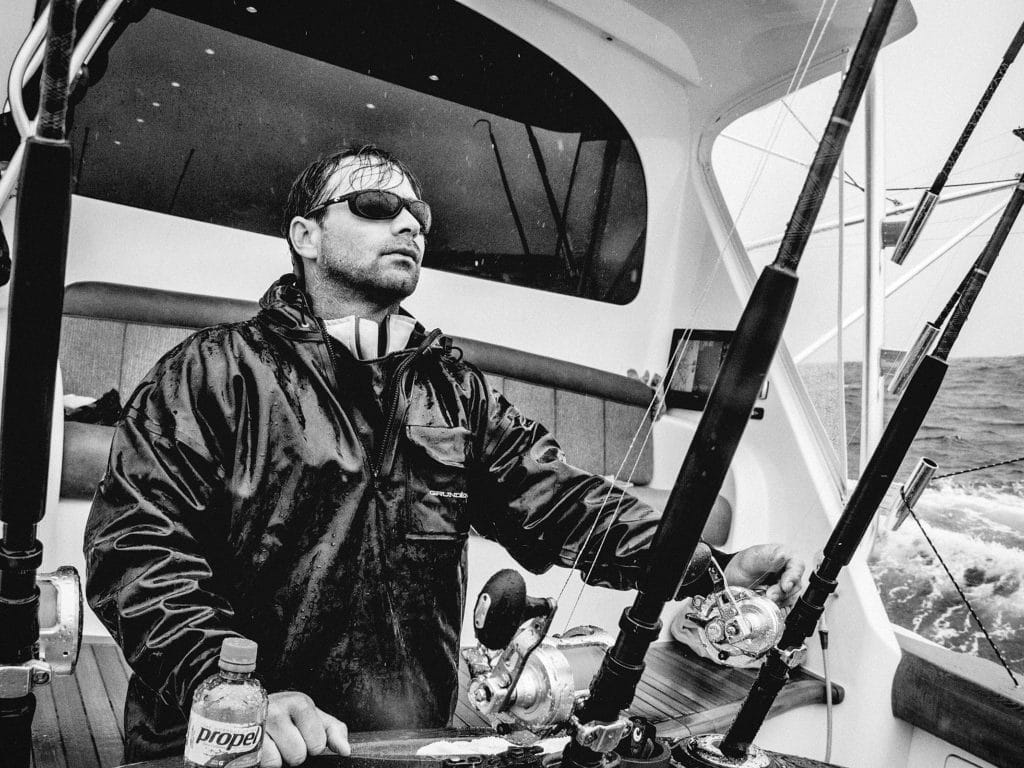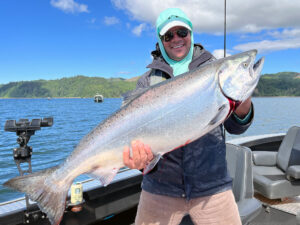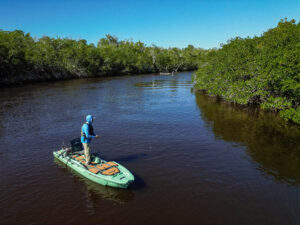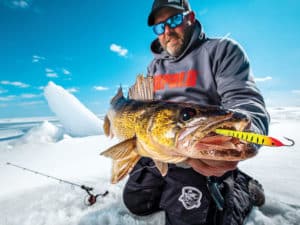“Don’t f— this up for us, Chris,” Carmine Caruso jokingly warned me with his best Jersey inflection, as he pulled the line from the left outrigger to check a bait.
I was riding along on Caruso’s 70-foot Viking, Pipe Dreamer, in late January, while his team competed in the 53rd Buccaneer Cup Sailfish Release Tournament out of West Palm Beach, Florida. Even though Caruso had cautioned me in jest, his words testified to the pressure his crew endures during a tournament workday.
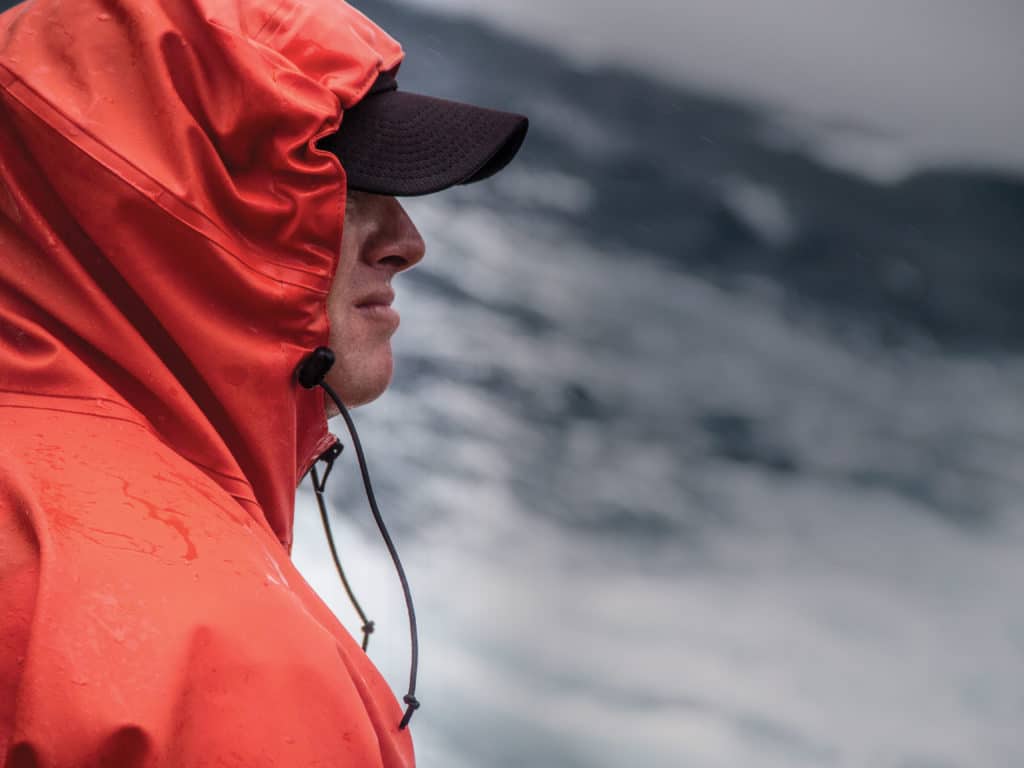
There are no cubicles, no calendar alerts for Mike Mahon and Geoff Flynt, the mates on Pipe Dreamer. They trade a suit and tie for a bib and boots. It’s not a nine-to-fiver gig. Sleep seems to be the only break they get. Being a mate is backbreaking work that lasts a lifetime. Mahon and Flynt are in it for the long haul.
6:32 a.m. Friday, January 22: The sky is pitch-black above the docks at Cannonsport Marina. Mahon and Flynt prepare baits. Everyone on board has his first morning cup of coffee. The mates must finish two dozen more ballyhoo rigs. Mahon squeezes the (literal) crap out of each ballyhoo for a better presentation in the water. The prior evening, the two spent more than three hours rigging 80 hook baits and over 100 mullet for the dredges. As reggae music plays through the boat’s sound system, the team — the mates, owner, captain and two other anglers — discusses the rough weather forecast. A nasty front is moving across the state — storms likely.
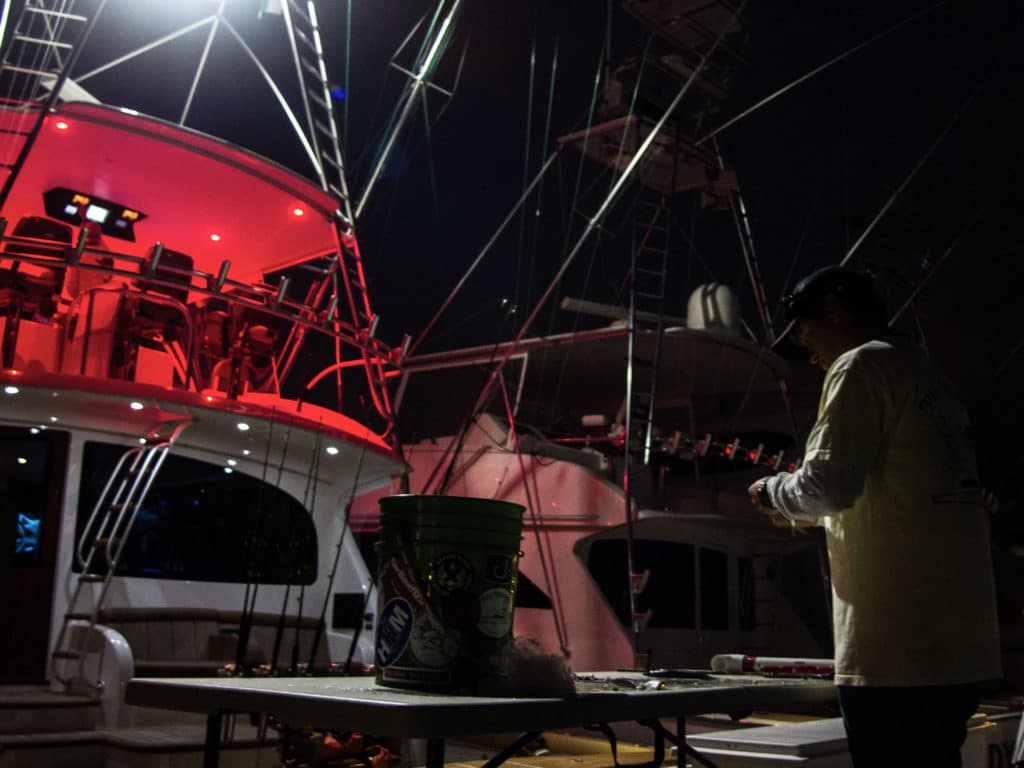
Preparation Makes Perfect
“Our job is to make the team look good,” says 32-year-old full-time first mate Mahon. “A team that looks good is due to the amount of work ahead of time. You can’t go offshore without enough equipment and baits. To competitively fish, we have to prepare.”
From making perfect dredges to stowing enough backup hooks and leaders, Mahon demonstrates a healthy obsession with having all the necessities. Flynt, a 41-year-old freelance mate from Morehead City, North Carolina, follows the same path.
“Preparation by the mate is one of the most important factors,” Flynt says. “Good numbers depend on two things: great preparation, and the captain putting the crew in front of opportunities. Once you’re in front of a good bite and they start snappin’, the team has to count on the mates’ preparation.”
A week before the tournament, Mahon spends time picking out specific baits to use. Being picky isn’t simply an attitude specific to him; it’s a time-tested tournament strategy.
He’s “got a guy” in Islamorada, Florida, who serves up some of the best fresh ballyhoo. He’s “got another guy” in Fort Pierce, Florida, who offers equally fresh mullet. Mahon makes it his business to know the ins and outs of bait-buying; add to that the best rods, reels and tackle. If you don’t have quality bait and gear in your repertoire, he feels, you’re not performing up to snuff as a mate.
“I have to always be prepared; otherwise it doesn’t cut it at the higher level,” he says. “Our owner gets the amount of prep work that goes into it. Sometimes other owners don’t understand the preparation. But I come in the night before, working through the night and making sure we have everything we need.”
For Mahon, it’s also about hospitality and attitude.
“These owners are spending tons of money, and they want to be successful on their trips,” he says. “If you’re too hard on them or too grumpy, they can find somebody else. As mates, we are part hospitality, part fishing.”
Flynt’s in the same camp, but he adds that the job can’t be fully understood without firsthand experience. “Nobody truly knows how hard it is,” he says. “It’s acknowledged, but no one knows how hard it can be unless you have actually done it.”
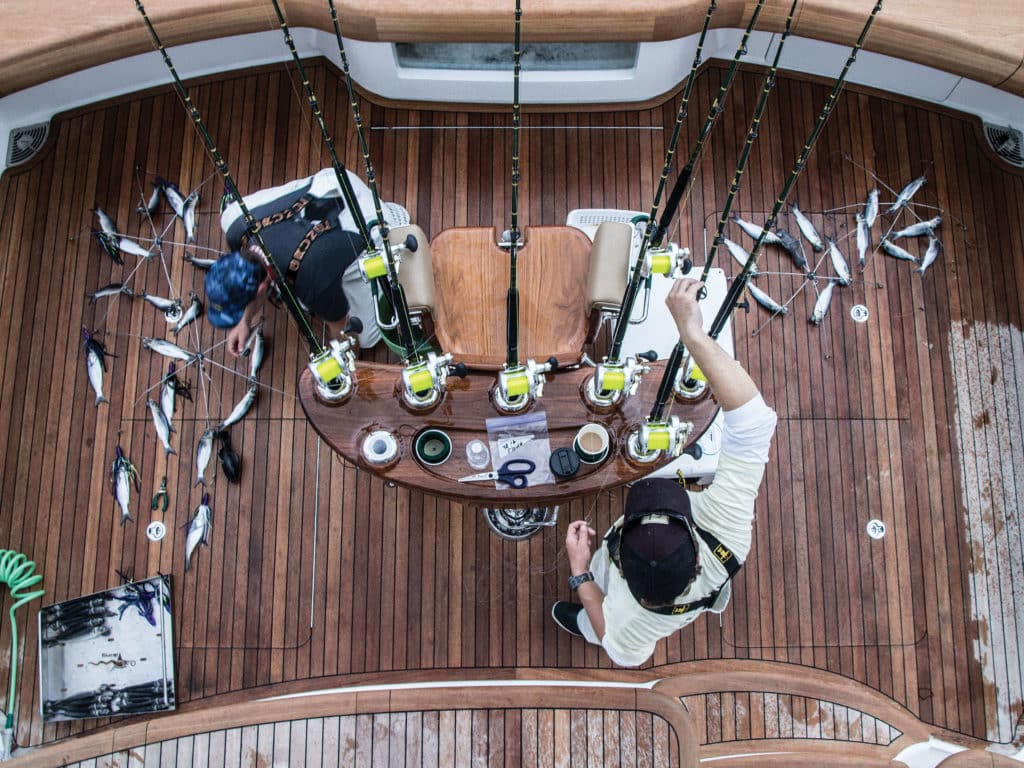
This is one job where no amount of reading, listening or learning will ever compete with the knowledge of doing, actually living it day to day. The majority of my skills come from experience.
7:17 a.m.: The sun peeks through the thick clouds looming overhead. After the mates make leaders and connections for each rod, they start the dredge process. They lay out two dredges that look more like supersize mobiles for baby cribs, but instead of moons and stars, the mates hang dead mullet, 30 on each dredge, while kneeling on the cockpit sole. They hold up each dredge to make sure all baits are secure and prepared for deployment. All aboard are at least three coffees deep into the day.
Mahon wasn’t always intent on diving 100 percent into the mate world. He tried his hand at teaching school, but something remained amiss. “I missed wearing flip-flops and working on beautiful boats on the water,” he says. “I wanted to go all in and spend more time fishing, more time on tournaments.”
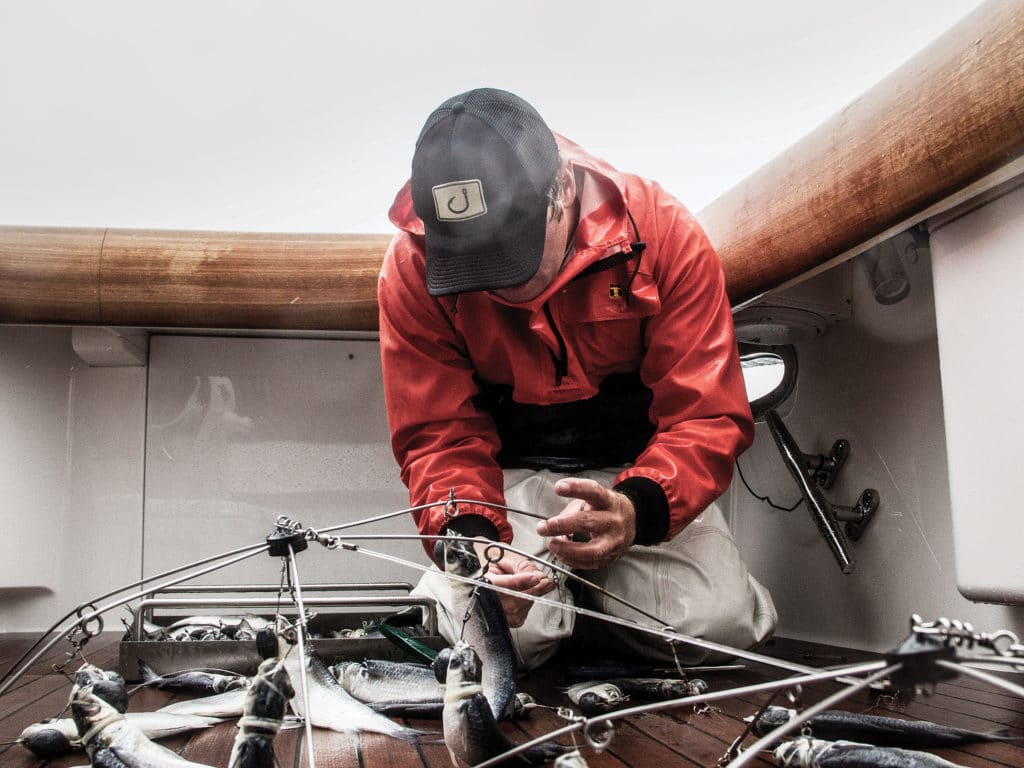
7:47 a.m.: Pipe Dreamer heads offshore. Storm clouds and heavy swells lie ahead. The wind blows around 25 knots with light rain. As the team members sit in the salon and pull on their rain gear, the mates check drags and test knot strength and connections. They wait for the clock to hit 8 a.m. for lines in. Golden Earring’s “Radar Love” blasts in the cockpit. Everyone stands facing aft, ready to pick up rods; the mates scan the water for signs of bait or fish.
On the other hand, Flynt has been in this business for more than 20 years, with an estimated 4,000 days out on the ocean. He previously freelanced aboard Pipe Dreamer, after first meeting the team in the Bahamas, where Caruso saw that he could handle high-stakes tournaments.
Even with all his time on the water, Flynt’s approach hasn’t changed that much. He’s all about the living, breathing side of know-how.
“I learn every time I go out,” he says. “This is one job where no amount of reading, listening or learning will ever compete with the knowledge of doing, actually living it day to day. The majority of my skills come from experience.”
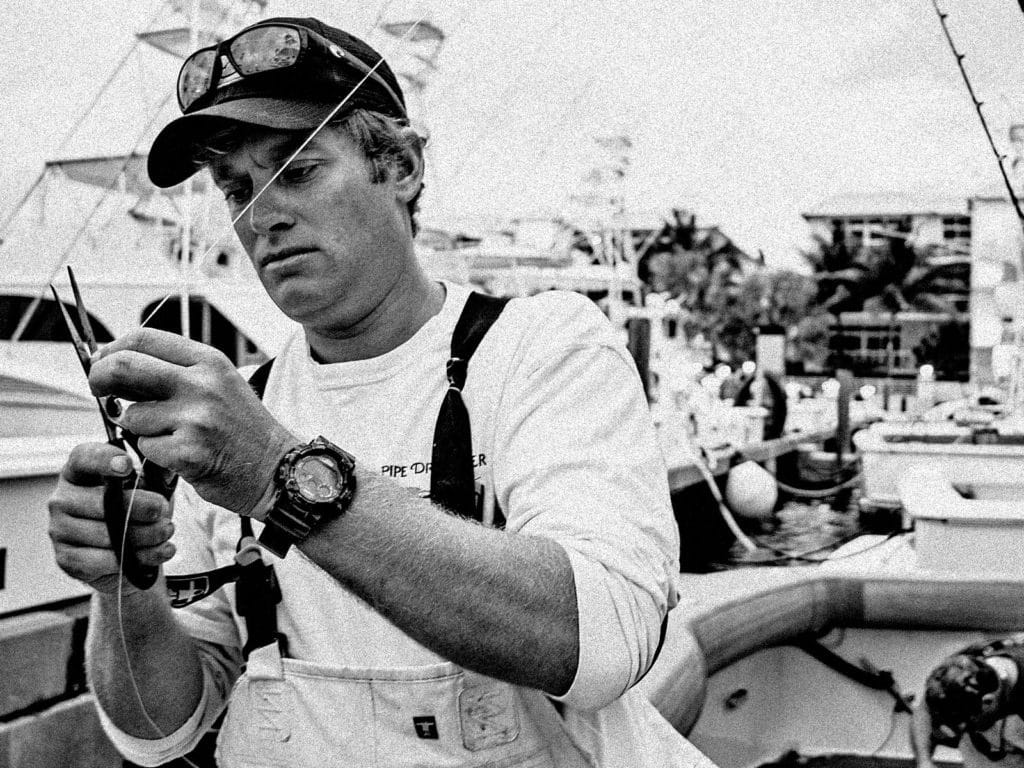
Up the Totem Pole
Aboard a competitive boat, hierarchy changes with the wind. At times, the owner takes full command. He can request anything from a fighting belt to DirecTV passwords.
Then, in one turn of events, all ears and eyes can be on the mates.
“We have to completely instruct our crew and anglers about being productive and efficient as a team,” Flynt says. “A good mate will be able to calmly guide anglers in a way that’s understandable. Well-trained mates can run the whole show in the cockpit, even guide the captain at certain times.”
8:43 a.m.: With two dredges, two flat lines and two lines in the riggers, the team waits for the first hit. Thirty yards back, Mahon spots a kingfish rocketing out of the boat’s wake. Minutes later, the right rigger line goes limp. Flynt attaches a new ballyhoo to the right rigger rod. Over the next hour, bonito after bonito — with one blackfin tuna mixed in — comes to the boat. With each release comes another rig to deploy — only now, the mates no longer work at a stationary table on land, but on a slick cooler in a storm-tossed sea.
There’s a pecking order in the cockpit, one that also transfers to the dock. Mates earn their spots to survive. But just surviving isn’t enough for Mahon; he looks beyond his current role. He’d like to earn a position on the bridge.
“Like anything in life, we all have building blocks for ourselves,” he says. “We learn from the ground up. Most good captains were good mates first. And if they aren’t, we call them ‘long-legged’ — meaning that somehow they walked all the way from the docks and straight to the bridge. You have to spend hours on the rigging table. You have to put in your dues.”
9:51 a.m.: It’s officially raining. With the combination of backing down and rain, nothing in the cockpit is dry. Even the paper towels hanging in the corner of the mezzanine are soaked. The mates and team hold on as the boat rocks over seven-footers. They see a couple of swells pushing 10 feet high. Radio chatter indicates other teams are heading back in — but not Pipe Dreamer.
10:18 a.m.: Caruso spots a bite on the left rigger bait. He reels in a 15-pound dolphin as Mahon helps wire the fish to the boat. In one swift motion, Mahon gaffs the fish, moves it to the ice-filled box, and puts the gaff back in the holder. Within 10 minutes, another smaller dolphin hooks up. Mahon slings in the fish without gaffing and drops it in the box.
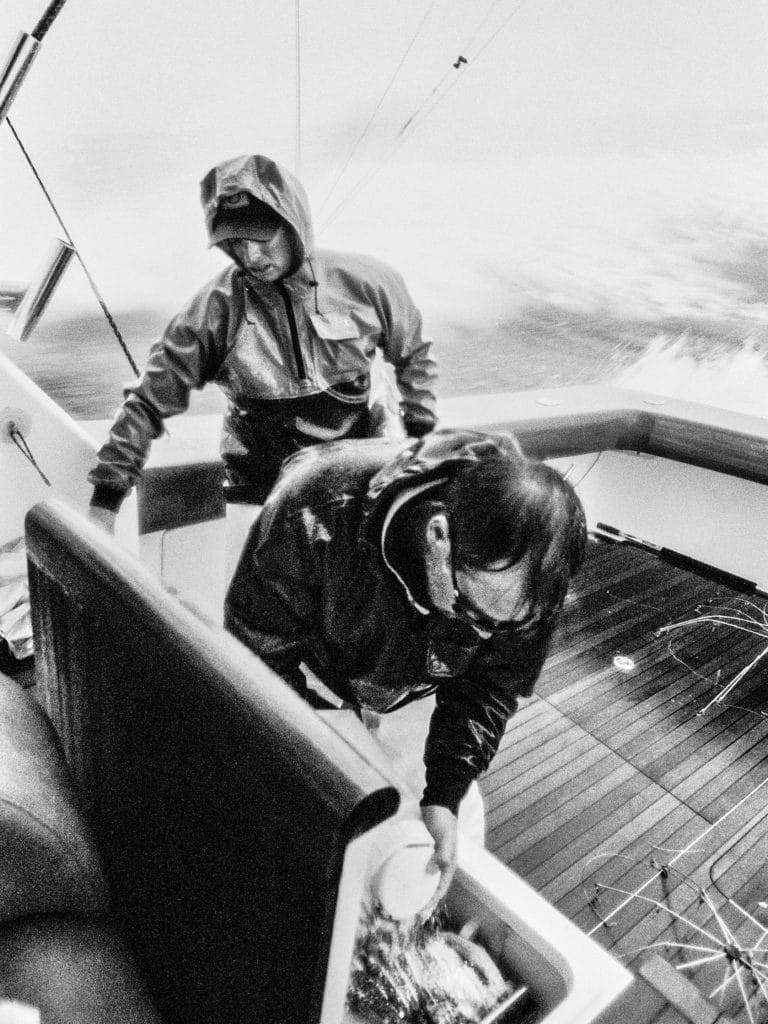
The Network
The fishing industry offers no mate school. Education comes from friends, and then friends become mentors. The lessons groom a mate from within, testing competition and pride.
“You may get nice compliments from your team,” Mahon says, “but there’s nothing like it when other mates and captains give you respect. When you get that congrats from your buddies, that’s the best.”
The kudos fuel him to strive harder and show his teachers that what he learned hasn’t been lost. Mahon’s primary teachers included Mike and Jeff Hudson, who operate a New Jersey charter business, and his friend Jeff Thiel.
Flynt’s skills evolved from day-in-day-out charter fishing, but as with Mahon, his success came from the coaches who surrounded him.
“My initial 10 years came from charter fishing,” Flynt says. “I was very fortunate to fish with some very skilled people, which made it possible to establish my roots in the right way.”
The learning didn’t stop there for Flynt. He continued working as a North Carolina charter mate. His boat averaged 220 days on the water each year.
12:38 p.m.: Lunch is served: roast-beef-and-cheese wraps and bags of chicken jerky. As the team eats, the mates straighten up the rods and gear. Flynt calls to the captain to bring up the dredges, not only to clean off the sargassum but to change out the worn baits for 60 more mullet.
In the mate world, it’s all about the exchange of information: who’s looking for a mate, who’s fishing a tournament, where’s the best bait, who’s available these days — a round of questions that seems repetitive.
2:15 p.m.: After several more bonehead bonito, more rain and more swiped baits, the team starts losing its gung-ho attitude. Mahon won’t let that happen. He rags on the team while simultaneously lifting their spirits. They get their mojo back. With heavy rainfall, the mates take turns heading into the engine room to change into a dry set of clothes.
3:10 p.m.: Most of the team sits in the salon for a break. The mates just now get to their lunch. Mahon stands with a wrap in one hand and a rod in the other. The mates prepare the boat to head back once lines out is called.
The mate network doesn’t rely on Internet forum chatter. It’s direct, the result of face-to-face or phone contact, which leads to camaraderie and loyalty. Backstabbers here beware; mates are through-and-through buddies. Each mate knows this is his or her livelihood and treats it as such.
3:21 p.m.: With only nine minutes left, both mates watch their baits with the same attentiveness as during the very first minute of the tournament.
Tournament Style
Mates truly show their abilities during tournaments: Time to shine or die. Sometimes, even with all their efforts and preparation, mates can’t control what fights below. Mahon knows the highs and lows of winning and losing. But he also knows that it’s his job to keep the team trying.
“Owners put up a lot of coin because they want to win as well,” he says. “I don’t want to give up. Even if it’s five minutes left, I am thinking we could catch four at once and put us in the running. I never give up.”
Flynt is right there with Mahon on tournament work. He believes in a no-holds-barred method with a side of satisfaction for all aboard.
“Tournament crews should always go the extra mile,” Flynt says. “Let the competition drive us to be the best we can be. Knowing the amount of money owners have paid to enter should help inspire a mate to make him really proud.”
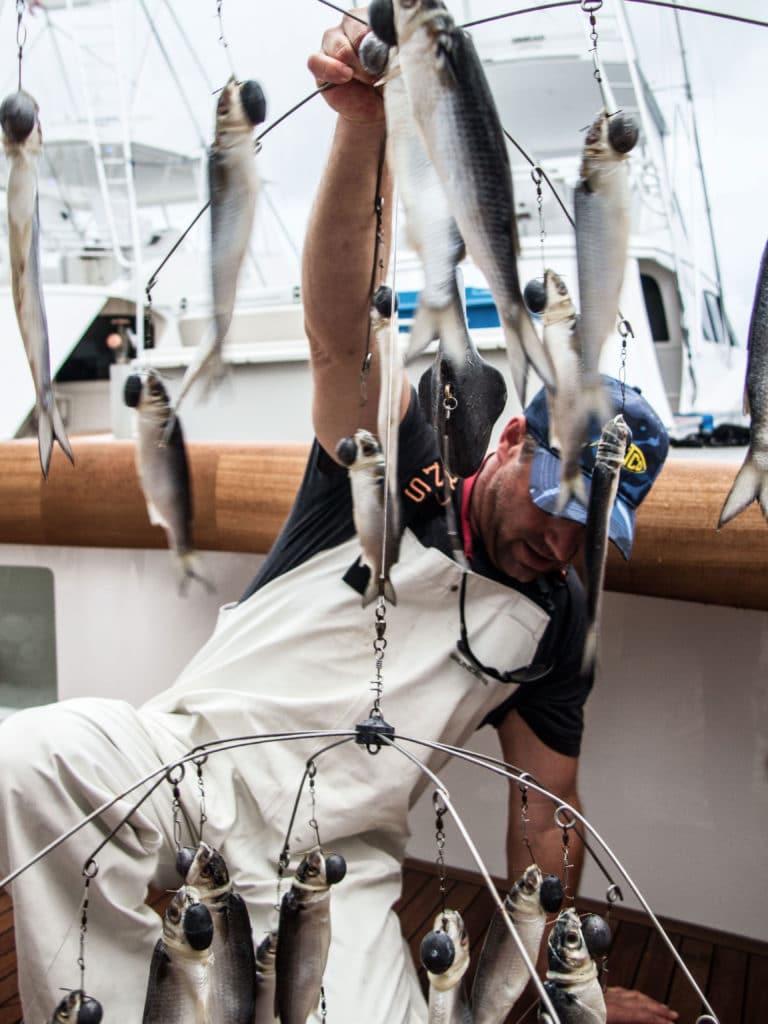
Flynt’s Mantra
3:34 p.m.: Dredges up, riggers down — time to fully pack. The team moves inside as the mates clear the entire cockpit. They work together, pulling in the baits and dredges on each side. They take off each leftover mullet from the dredge and place it in the freezer. They add salt, hoping the bait will last longer — for Day Two — and stay firm. They take off all the rigs and place the ballyhoo in the freezer as well. They put away the dredges, store the tackle, clean up the garbage, wipe down the mezzanine seats, wash down the cockpit — everything but drive the boat.
5:13 p.m.: The rain hasn’t let up. Pipe Dreamer pulls into Sailfish Marina to drop off the tournament observer. Mahon ties up the boat and hands over the bigger of the dolphin at the weigh station. At that time of day, it tops the leaderboard for the species.
The days roll into nights for mates. Their job doesn’t end at the docks. From dinners with crew to discussion of next-day changes to rerigging equipment, the work continues.
The mates’ circadian rhythms revolve around repetition and routine. That practice evolves high-performance mates: ones who stick around, ones who succeed in top tournaments. They might wish for the big check and the golden trophy, but they have to put in the work first.
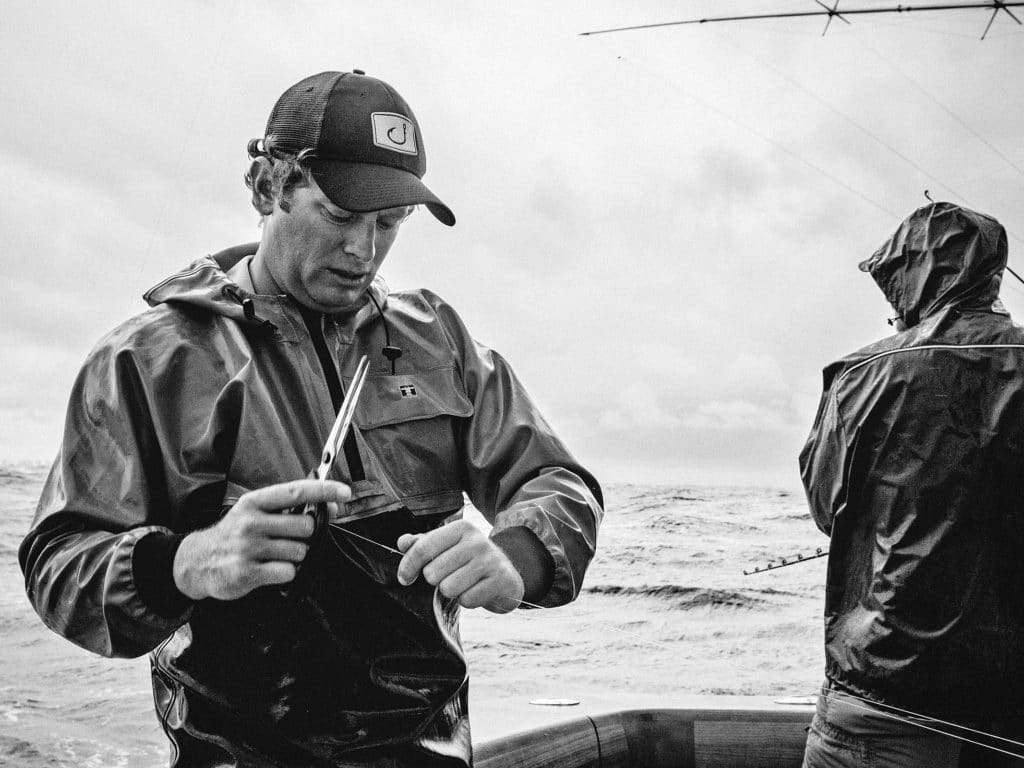
Mike Mahon
